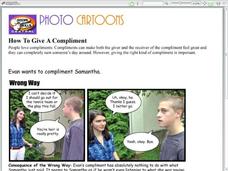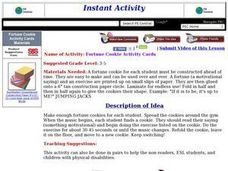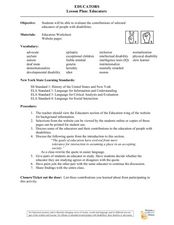Perkins School for the Blind
Volume, Mass, and Density Boxes
Mass and density are difficult topics for kids to understand, and even more difficult when you have visual impairments or blindness. Learners will make boxes and fill them with cotton, sand, or crushed paper. They will feel the density...
Perkins School for the Blind
Safety Crash Testing
Everyone knows that cars have safety features, but wouldn't it be fun to design your own? Learners with visual impairments build a ramp and then attempt to use the material provided to design a safety system to protect a raw egg from a...
Perkins School for the Blind
Figure Eight Walking
Walking in a straight line is one thing. Walking while trying to shift your weight from side to side to maintain balance is another challenge altogether. Learners with visual impairments practice walking in a figure eight. Cones are set...
Perkins School for the Blind
Beanbag Toss
Why is learning how to catch and toss so important? If one has visual impairments, learning this basic skill will help him increase orientation and mobility, coordination, and cognitive development,. Mastery of this skill will also mean...
Social Skills Central
Photo Cartoons: How To Give A Compliment
Help learners develop the ability to offer appropriate, meaningful compliments to others—an essential social skill. Here you'll find a quick photo cartoon illustrating a right and wrong way to give a compliment, as well as a brief...
Workforce Solutions
Let’s Take a Selfie
Professional or unprofessional? That is the question addressed by a lesson plan on workplace attire. Class members examine images posted on job search sites like Linkedin and those posted by celebrities. They consider the implications of...
Workforce Solutions
On the Job
Four lessons spotlight a variety of professions while boosting listening and observational skills and making inferences. Lesson one challenges pupils to group cards based on a commonality then justify the relationship they see. Lesson...
Curated OER
Fortune Cookie Activity Cards
Young scholars are given a pre-made fortune cookie at the beginning of class. Individually, they open up the cookie and read their fortune and complete the exercise on the paper. They exchange fortunes and exercises with their classmates...
Curated OER
Artistic Expression
Students analyze Frida Kahlo's paintings to determine how she used them for self-expression. They create a personal piece of art to express sentiments on a particular subject.
Curated OER
What in the World..?!?
Students photograph mystery images. In this observation skills instructional activity, students gather everyday objects and place them under a digital microscope. They magnify the image and take a photograph of it. The image is then...
Curated OER
Life of a Soldier after the Civil War Lesson Plan: What's in a Name
Students explore the concept of institutional bias. In this Civil War lesson, students read case studies on the treatment of Irish and African-American veterans who did not receive their pensions from the war. Students discuss their...
Curated OER
Collage Butterflies
Students make their own butterfly on contact paper. In this art lesson, students cut or tear small pieces of tissue paper to put on their butterfly. Students place another piece of contact paper over the tissue paper pieces and cut the...
Curated OER
Number Line Locomotion
Here is a great lesson that incorporates movement into academic learning. Students improve addition subtraction skills by using number lines and locomotor movement.
Curated OER
Educators
After viewing selections from a website and discussing the role of the teacher in educating the disabled, students work in pairs. They analyze the work of an educator and relate the work to a given quote, then decide if that quote fits...
Curated OER
FACS: Recreation Therapy
An attractive and informative nine-slide PowerPoint introduces the class to the world of recreational therapy. Attached handouts provide team-building and ice-breaker activities. The activities are engaging. They serve as examples of...
Curated OER
Fun Bones
Use the hokey pokey music to teach the names of some of the major bones in the human body. Circle up, put on the music, and put your right radius in. Use this in an anatomy class to spice things up a bit!
American Psychological Association
Developing Adolescents
Why to young people act the way they do? Scholars investigate the stages of adolescent development incorporating high school psychology techniques. Using research from the American Psychological Association, they uncover the five areas...
Curated OER
Credit - Good? Bad?
Students examine credit cards. They explore the detrimental effects that result from debt and poor credit. Students analyze interest rates, minimum balances, and consumer debt. Students survey the benefits of credit cards.
Curated OER
Flag Etiquette
Students study flag etiquette. In this US flag lesson, students explore the flag and its history. Students also demonstrate the proper procedures for folding a U.S. flag.
Perkins School for the Blind
Friction
Friction is a force that can be felt, which means that learners with visual impairments can experiment to feel and understand the concept of friction. They slide a rock along a smooth table, and then they slide a rock across sandpaper,...
Perkins School for the Blind
Bean Bag on My Head
The world is a very different place to those who are blind. That is why it is so important to have your kids with visual impairments explore the world in many different ways. For this activity, a bean bag is placed on the child's head,...
Curated OER
Translating Science Into Public Policy
Students role-play participants at a panel on climate change. They represent either scientists or policymakers. "Scientists" use the information they've learned in other classes and assignments to present information to "policymakers,"...
Curated OER
Predator Or Prey?
Students study the concept of predator/prey by researching specific examples of birds. They participate in a concept map/webbing activity to determine different characteristics of birds. They engage in a class discussion about...

























